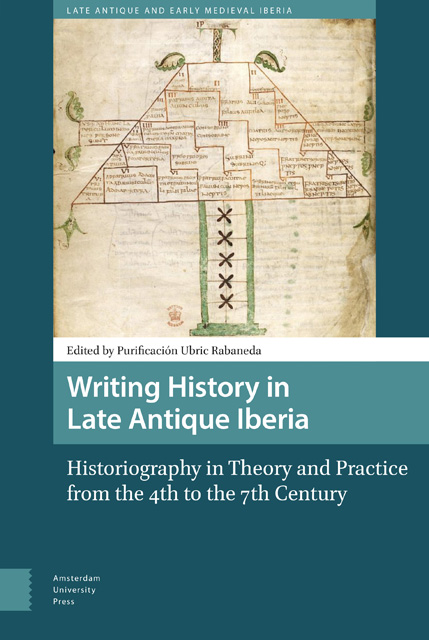 Writing History in Late Antique Iberia
Writing History in Late Antique Iberia Book contents
- Frontmatter
- Table of Contents
- 1 Writing History in Late Antique Iberia: Theory and Praxis
- 2 Para qué sirve la Historia : Principios teóricos de la historiografía hispana tardoantigua
- 3 From Christian Historiography to the Emergence of National Histories : Spanish Historiography between Romans and Visigoths
- 4 Orosius: An Iberian Patriot’s History of Rome
- 5 Orosius, Barbarians, and the Christian Success Story
- 6 Prophecies and Omens of the Fall of the Roman Empire in the Chronicle of Hydatius of Lemica
- 7 La dimensión política de los historiadores del reino visigodo de Toledo
- 8 The Definitions and Uses of Historia in Isidore of Seville
- 9 Bishops and Their Biographers : The Praxis of History Writing in Visigothic Iberia
- 10 Local Powers and Construction of the Past in the Visigothic Kingdom of Hispania
- 11 The Contemplation of the Past in the Libellus Precum of Faustinus (and Marcellinus)
- 12 Orthodoxy and Heterodoxy : The Historiography of Hispania in Late Antiquity
- 13 Expulsados de la Historia : El argumento histórico en la polémica antijudía hispana (siglos IV-VII)
- 14 Consideraciones sobre la temporalidad en las Vitae Sanctorum visigóticas
- 15 The Image of Leovigild as Arian Monarch in the ‘Vitas Patrum Emeritensium’ : From Historical Reality to Hagiographical Deformation
- Index
14 - Consideraciones sobre la temporalidad en las Vitae Sanctorum visigóticas
Published online by Cambridge University Press: 18 April 2023
- Frontmatter
- Table of Contents
- 1 Writing History in Late Antique Iberia: Theory and Praxis
- 2 Para qué sirve la Historia : Principios teóricos de la historiografía hispana tardoantigua
- 3 From Christian Historiography to the Emergence of National Histories : Spanish Historiography between Romans and Visigoths
- 4 Orosius: An Iberian Patriot’s History of Rome
- 5 Orosius, Barbarians, and the Christian Success Story
- 6 Prophecies and Omens of the Fall of the Roman Empire in the Chronicle of Hydatius of Lemica
- 7 La dimensión política de los historiadores del reino visigodo de Toledo
- 8 The Definitions and Uses of Historia in Isidore of Seville
- 9 Bishops and Their Biographers : The Praxis of History Writing in Visigothic Iberia
- 10 Local Powers and Construction of the Past in the Visigothic Kingdom of Hispania
- 11 The Contemplation of the Past in the Libellus Precum of Faustinus (and Marcellinus)
- 12 Orthodoxy and Heterodoxy : The Historiography of Hispania in Late Antiquity
- 13 Expulsados de la Historia : El argumento histórico en la polémica antijudía hispana (siglos IV-VII)
- 14 Consideraciones sobre la temporalidad en las Vitae Sanctorum visigóticas
- 15 The Image of Leovigild as Arian Monarch in the ‘Vitas Patrum Emeritensium’ : From Historical Reality to Hagiographical Deformation
- Index
Summary
Abstract
This chapter addresses a detailed analysis of the temporality present in the hagiographic literature of Late Antiquite Hispania and specifically in the bio-hagiographies of the Visigoth period, a production that is not very abundant in comparative terms with that of other geographical areas, but of great interest. By means of the same one it is evidenced that these compositions use a certainly historical time frame, common characteristic to all biographical narration, but by means of artifices and a story of topical character they manage to transmit to their readers/ listeners an idealised temporal building and, above all, providentialist, always presided over by the divine intervention and its agents, the holy men, constant protagonists of salvific acts.
Keywords: Hispania, Late Antiquity, Visigothic hagiography, biographies, time
Quid est enim tempus? Quis hoc facile breuiterque explicauerit?
Aug., Conf. 11,14,17
Temporalidad y narrativa hagiográfica
Fruto de la visión rectilínea y teleológica de la historia –de la Historia de Salvación- propia del cristianismo, los seguidores de esta religión tienen una fuerte conciencia de la naturaleza del tiempo, de su continuidad e irreversibilidad. Para los cristianos el tiempo siempre hace referencia a una realidad, a algo ya vivido, que se está viviendo o que se espera vivir, todo ello irrepetible y conectado. En consecuencia, pasado, presente y futuro tienen un valor absoluto. De igual forma, antes, ahora y después adquieren un significado relativo o relacional.
Así concebido, el tiempo es un elemento esencial, consustancial, a la narrativa cristiana. El subgénero hagiográfico, por más que peculiar, no pude escapar de esta máxima por sus pretensiones de carácter historiográfico. Y sin embargo, no cabe ver en estos escritos una perfecta sucesión temporal o cronológica.
Dentro de las narraciones hagiográficas contamos con dos tipos principales: los relatos martiriales y las biografías de santos. Por lo que se refiere a los relatos martiriales, en concreto a los comprendidos en el Passionarium Hispanicum , el asunto que nos ocupa, aparentemente, no reviste mayor complejidad. A la par que destaca la presencia de la conjunción cum –junto con sus equivalentes y locuciones-con valor temporal, el llamado cum histórico, aparecen dos tiempos claramente definidos: pasado (la propia narración del martirio, habitualmente encabezada por la conjunción igitur ) y presente (emplazamiento de las reliquias y celebraciones diversas).
- Type
- Chapter
- Information
- Writing History in Late Antique IberiaHistoriography in Theory and Practice from the 4th to the 7th Century, pp. 273 - 292Publisher: Amsterdam University PressPrint publication year: 2022
